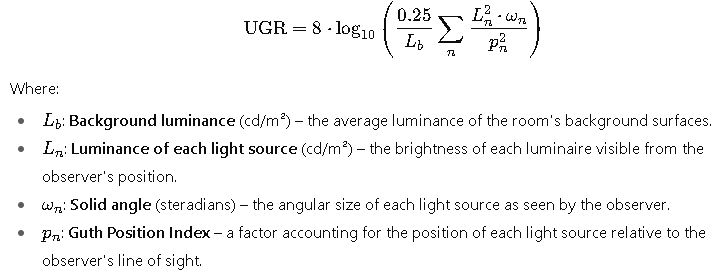The Unified Glare Rating (UGR) quantifies discomfort glare, ensuring proper lighting design for indoor environments. Developed by the International Commission on Illumination (CIE) in 1995, UGR standardizes glare assessment.
UGR — Unified Glare Rating Calculator
| Luminance L (cd/m²) | Solid angle ω (sr) | Position index p | Actions |
|---|
UGR = 8 · log10( (0.25 / Lb) · Σ (Lᵢ² · ωᵢ / pᵢ²) )UGR Calculation Formula and Variables
The UGR is calculated using the following formula:

Detailed Explanation of Variables
- Background Luminance (Lb): Represents the average brightness of the room’s background surfaces, such as walls and ceilings. This value influences the eye’s adaptation level and affects glare perception.
- Luminance of Each Light Source (Ln): The brightness of each luminaire visible to the observer. Higher luminance values increase the likelihood of discomfort glare.
- Solid Angle (ωn): The angular size of the light source as perceived by the observer. Larger light sources subtend a greater solid angle, contributing more to glare.
- Guth Position Index (pn): A dimensionless factor that adjusts for the position of each light source relative to the observer’s line of sight. It accounts for the angular displacement of the light source from the observer’s direct view.
Common UGR Values and Their Implications
The following table outlines typical UGR values and their corresponding levels of discomfort glare:
| UGR Value | Discomfort Level | Recommended Applications |
|---|---|---|
| 10 | Negligible glare | Auditoriums, cinemas, art galleries |
| 13 | Very low glare | Offices, classrooms, libraries |
| 16 | Low glare | Conference rooms, meeting areas |
| 19 | Moderate glare | Open-plan offices, workstations |
| 22 | High glare | Industrial settings, workshops |
| 25 | Very high glare | Warehouses, production areas |
| 28 | Extremely high glare | Kitchens, bakeries, heavy industry |
| 30 | Unacceptable glare | Areas requiring visual precision |
Note: Values are based on CIE 117-1995 and EN 12464-1 standards.
Real-World Application Examples
Example 1: Office Lighting Design
Scenario: Designing lighting for an open-plan office with a ceiling height of 2.7 meters, using LED panel luminaires with a luminous flux of 4000 lm.
Calculation Steps:
1.Determine Room Parameters:
- Room dimensions: 10m x 8m
- Ceiling reflectance: 0.8
- Wall reflectance: 0.5
- Floor reflectance: 0.3
- Select Luminaires:

3.Calculate Background Luminance (Lb):
Using the room’s reflectance values and dimensions, calculate the background luminance.
4.Apply UGR Formula:
Substitute the values into the UGR formula to compute the discomfort glare level.
Outcome: The calculated UGR value is 18, indicating a low level of discomfort glare, suitable for office environments.
Example 2: Industrial Workshop Lighting
Scenario: Designing lighting for a workshop with a ceiling height of 4.5 meters, using high-bay LED luminaires with a luminous flux of 15000 lm.
Calculation Steps:
1.Determine Room Parameters:
- Room dimensions: 20m x 15m
- Ceiling reflectance: 0.9
- Wall reflectance: 0.6
- Floor reflectance: 0.4

3.Calculate Background Luminance (Lb):
Using the room’s reflectance values and dimensions, calculate the background luminance.
4.Apply UGR Formula:
Substitute the values into the UGR formula to compute the discomfort glare level.
Outcome: The calculated UGR value is 24, indicating a high level of discomfort glare, which may require adjustments in luminaire placement or additional shielding.
Advanced Considerations and Optimization Strategies
To achieve optimal lighting conditions and minimize discomfort glare, consider the following strategies:
- Luminaire Placement: Position luminaires to ensure uniform light distribution and minimize direct line-of-sight to bright light sources.
- Use of Diffusers and Lenses: Employ diffusers or lenses to scatter light and reduce direct luminance from individual light sources.
- Adjusting Reflectance Values: Modify room surface reflectance to enhance background luminance, aiding in glare reduction.
- Implementing Dimming Controls: Utilize dimming systems to adjust light levels based on ambient conditions and occupant needs.
- Regular Maintenance: Ensure luminaires are clean and functioning correctly to maintain consistent light output and minimize glare.